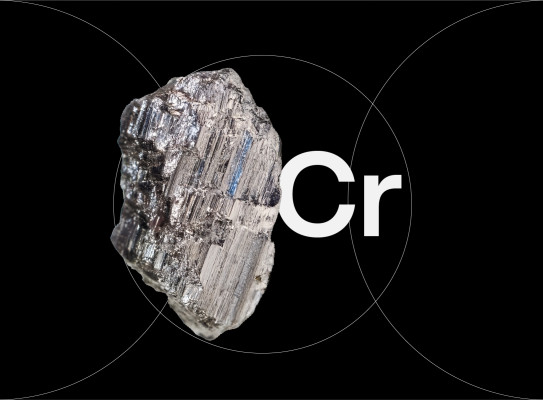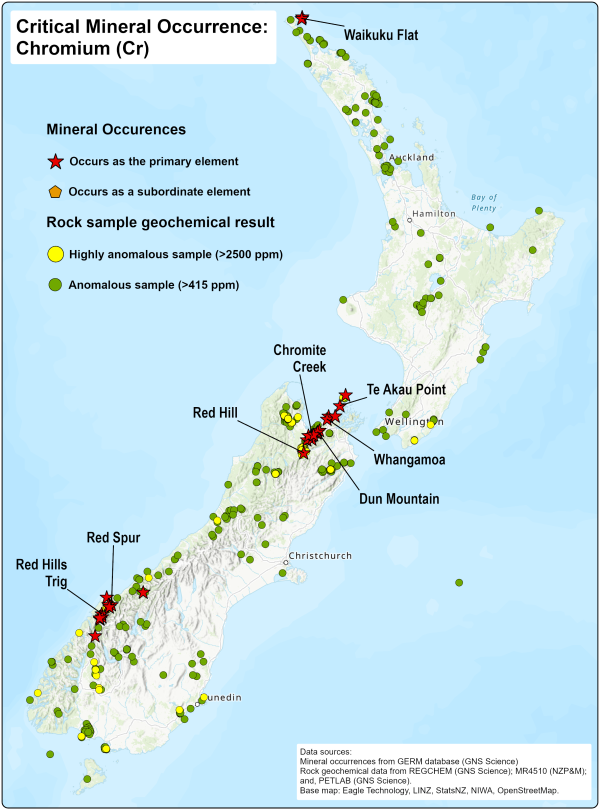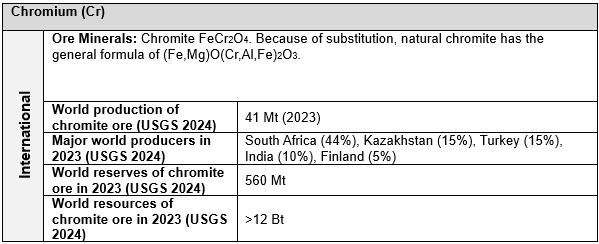Chromium

Chromium (Cr) is a vital industrial metal known for its hardness, corrosion resistance, and ability to form alloys. It is essential for producing stainless steel, specialised alloys, and industrial coatings, making it a key material in modern infrastructure, manufacturing, and technology.
Chromium in New Zealand
The main occurrences of the chromium mineral chromite (Mg,Fe)Cr₂O₄ are in ultramafic rocks of the Dun Mountain Ophiolite Belt in east Nelson and northern Otago. About 6000 t of chromite ore (20–54% Cr₂O₃) were produced in the late 1800s from Dun Mountain, east of Nelson. Several companies have explored in other areas of the Dun Mountain Ophiolite Belt for nickel, chromium and copper deposits. Exploration in the 1980s identified a number of geochemically anomalous areas, with PGE in the parts per billion range. No detailed follow-up exploration has been carried out on any of these prospects.
Chromite is also found in podiform chromite deposits described in the podiform chromite model section below, as well as in small peridotite and serpentinite bodies near North Cape, Wellsford and Piopio in the North Island.
The potential for discovery of chromite deposits of significant size in the Dun Mountain Ophiolite Belt appears to be limited, as indicated from the small size and discontinuous style of the lenses worked last century, and their confinement to the cumulate part of the ultramafic rocks which are largely preserved in the Dun Mountain area. No significant chromium mineralisation has been reported from the Pounamu Ultramafics in Westland but there may be some potential for small deposits in these rocks.


Geological Occurrence
Chromium primarily occurs in the mineral chromite (FeCr₂O₄), which is found in ultramafic and mafic igneous rocks such as peridotites and layered intrusions. Major chromite deposits are associated with large igneous provinces, including the Bushveld Complex (South Africa), the Great Dyke (Zimbabwe), and the Stillwater Complex (USA).
Uses and Applications
- Stainless Steel & Alloys – Chromium’s most significant use is in stainless steel, where it enhances strength, durability, and corrosion resistance.
- Aerospace & Defense – Used in superalloys for jet engines and military applications.
- Refractory Materials – High-temperature furnaces and foundries rely on chromium-rich materials.
- Electroplating & Coatings – Provides a durable, corrosion-resistant finish for tools, machinery, and automotive parts.
- Pigments & Chemicals – Chromium compounds are used in dyes, paints, leather tanning, and wood preservation.
Strategic Importance
Chromium is classified as a critical mineral due to its essential industrial role and limited supply sources. Major global producers include South Africa, Kazakhstan, India, and Turkey. Many countries rely on imports, making chromium a strategic resource for national security and economic stability.
Exploration & Mining Opportunities
With growing demand for stainless steel and advanced materials, exploration for new chromite deposits is ongoing. Advances in geophysical surveys and remote sensing technologies aid in identifying new ore bodies, particularly in underexplored regions.
Future Outlook
As industries seek more durable and lightweight materials, demand for chromium is expected to remain strong. Recycling and sustainable mining practices will be essential in securing future supply.
Chromium’s unique properties and widespread industrial applications make it an indispensable element for modern society, driving continued exploration and investment in new resources.
Additional Reading
Brathwaite RL, Jongens RJ, Christie AB, Lukovic B. 2012c. Dun Mountain Ophiolite Belt, East Nelson: desktop study and geochemical survey for chromite ± PGE deposits and Cu-rich VMS deposits. Lower Hutt (NZ): GNS Science. 43 p. + appendices. (GNS Science report; 2012/10).
Brathwaite RL Christie AB, Jongens R. 2016. Exploration for chromite, platinum group element and nickel mineralisation in the Dun Mountain Ophiolite Belt, East Nelson. In: Christie AB, editor. Mineral deposits of New Zealand: exploration and research. Carlton (AU): Australasian Institute of Mining and Metallurgy. p. 463–470. (Australasian Institute of Mining and Metallurgy monograph series; 31).